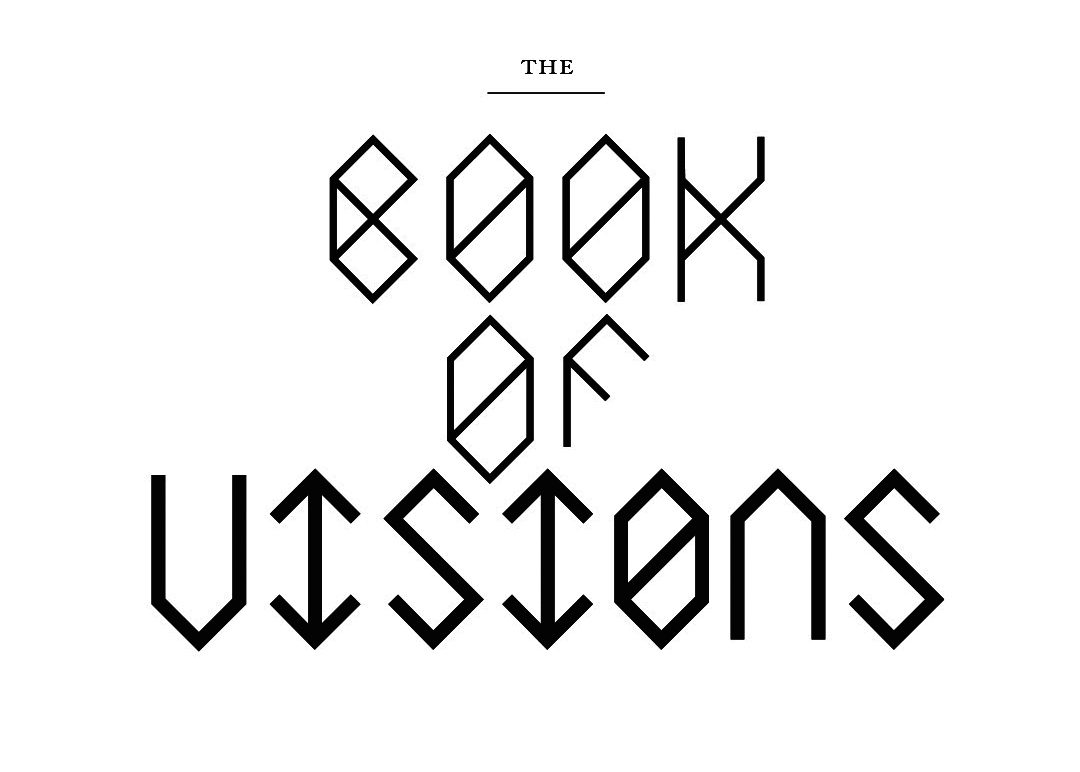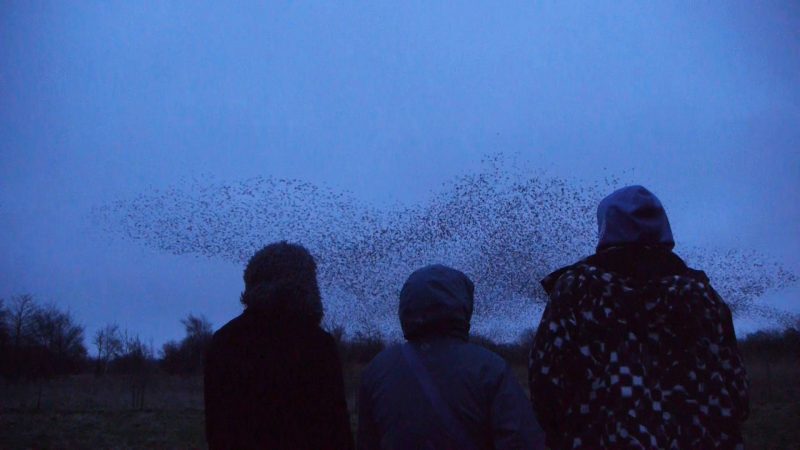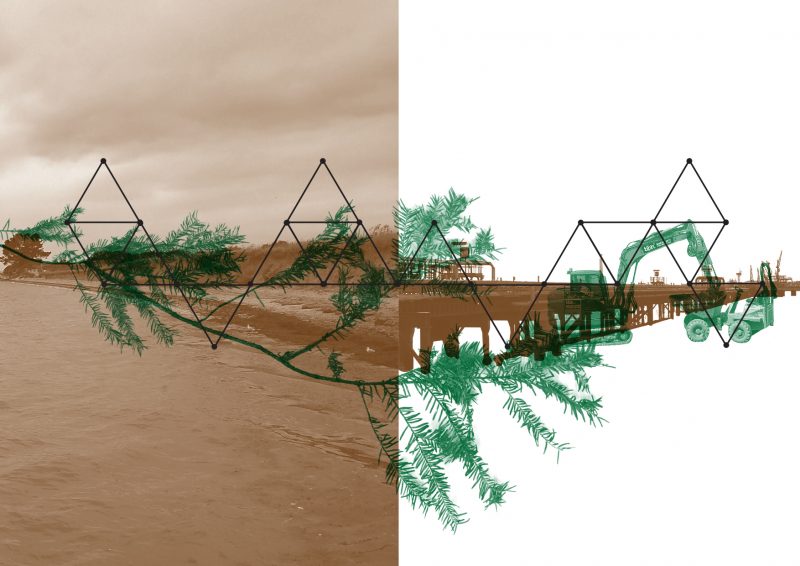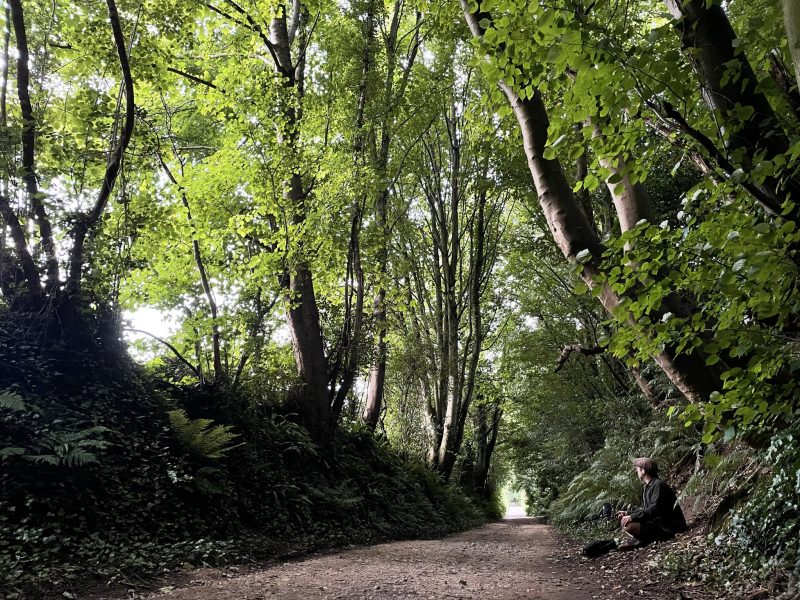Stump
It is early March. I am sitting on a tree stump behind a care home on the outskirts of Battle, looking out across fields and woodland to the east of the small town. I planned to return here in the winter, but a combination of pandemic, sprained ankle, and care-giving meant that didn’t happen. I’m here now. Closing my eyes in a brief deep listening and breathing exercise, a practice I have been cultivating each time I set out to walk, I become aware of a woodcutter nearby. The count of my inward breath falls in with the sound of the axe. As I breathe out, they stop. Breathe in, the axe starts again. We manage four of these cycles before falling out of sync. I open my eyes. The world is hanging on the tail end of winter. The birdsong seems richer than before I closed my eyes. Leaning into slowness, I encounter stillness.
Puddle
Immediately east of Battle the path goes through Great Wood, which has suffered heavily in Storm Eunice a couple of weeks ago. Beyond the trashed wood is a shabby and careless mess of industrial agriculture. I lose my hat in more than one toxic puddle, and intermittent piles of burning brush smoulder, tingeing the air. Passing through a particularly care-less farm, a JCB sits atop a pile of rubble, shovel dug in the earth like a pioneer leaning on his spade, projecting mastery over the surroundings. Nothing moves except a chained-up dog. What is the distinction between stillness and stagnation? At what point does the one become the other?
River
Past Westfield, it’s a relief to enter the medieval landscape of the High Weald, scattered farmsteads and pockets of woodland dotting the rolling fields. Birds of prey abound and herons monitor ancient stew ponds. As the sun dips, and the route opens out, I breathe easier and realize that it has taken me all day to slough off my nervous city energy, a jittering state of consciousness neither movement nor stillness, a perpetual motion machine reacting to the incessant flow of visual data, events, information, relationships and corresponding stress responses.
Under the ecstasy of vast skies over coastal flatlands, I turn north to Rye. With the primal whoop of an oystercatcher in my ears, I follow the pterodactylic lope of the cormorant down the river Rother at dusk. Those augurs of deep time bring me face to face with my misunderstanding; that stillness is a state of mind not body, and that the right practice of movement can conjure stillness. The ‘right’ practice, for me, relates to slowness. Later, a friend notes how closely my epiphany resembles a teaching from the T’ai Chi classics that ‘the movement found in stillness is greater than the movement found in movement. The stillness found in movement is deeper than the stillness found in stillness.’ In the morning, I set out inland, following the tidal river upstream.
Skyline
When I sprained my ankle in January, I did a tarot reading with a friend and drew the Hanged Man. Ways to read the card are as encouragement to take a different view, to practice the art of allowing, or to be at peace with what is. In other words, an appeal for stillness. As I walk, I consider what it means to hold stillness at the core of my movement. As a distraction or enhancement, I find myself photographing stiles, these fixed structures along the way that allow movement over obstacles, but also offer a seated moment of stillness and reflection. As a filmmaker, I often find my attention channelled through a lens, and am aware of the contradictions therein. Remembering John Clare – ‘he lolls upon each resting stile/ To see the fields so sweetly smile/To see the wheat grow green and long/ And list the weeders’ toiling song.’ – I sit for a moment and look towards a hazy structure on the skyline that marks out the strange and mythical land of Dungeness.
While making Acts Of Quiet Resistance, we did some filming around here, and I made a micro-pilgrimage to Dungeness, to Derek Jarman’s cottage. The rhythms of the world end there, it seems to have its own climate and building regulations; a micro-nation of seabirds, driftwood cottages and nuclear dread. Entering Kent, the final county of this pilgrimage, my thoughts turn to Riddley Walker, Russell Hoban’s novel charting the progress of a twelve year old boy-seer through this same Kent landscape, roughly two millennia in the future, ‘at the bitter end of the nuclear road’. This character from a twisted and ancient future has been a looming presence in the conscious margins of my pilgrimage, influencing even my choice of attire, and at Dungeness he is most prescient.
Bark
I turn over a piece of bark in my hand, riddled with the tracks of beetle and woodworm, and think about paths forged by walking. I think about this route that I’m following. I admire the conjuring out of history and myth that The British Pilgrimage Trust are attempting with the Old Way. It is not an ancient pilgrim route, if it was then I would most likely be following main roads all the way. I know this, and nonetheless have the conviction as I walk that I do so in the steps of ancient pilgrims. Does this make me an auto-mytho-ethnographer? As neo-pagans celebrate the Wheel Of the Year, they feel a deep connection to ancient druidic tradition and yet this drawing together of equinoxes and solstices with the ancient Celtic festivals can only be traced back the famous Wiccan priest Gerald Gardner’s Bricket Wood Coven in the 1950s. It doesn’t matter, maybe, if we are reviving traditions cast out by modernity, or creating new ones in their likeness. Either way, we look beyond modernity into deeper time for our inspiration, and that is enough. In the famous words of Saint Augustine – solvitur ambulando – ‘things are solved by walking’.
Shore
Around Appledore, the path begins following the Saxon Shore Way, an inland route that tracks the coast as it was prior to a huge storm in 1287 that re-drew the coastline in this area, destroying some towns and landlocking others that had been ports, and creating what we now know as Romney Marsh. The weather today is not quite so cataclysmic but nonetheless a bitter and gusty wind threatens to blow me sideways and sheets of rain whip over the flats from the sea. I imagine myself as seen from a distance across the salt flats; head down, shoulder into the weather, flapping overcoat, staff lugubriously aiding forward movement, the very image of the pilgrim archetype. The land does not actually shift under my feet as I’m walking, but the relatively recent re-structuring, in geological terms, give an illusion, or maybe allude to the reality, of impermanence, that provides an insight into my pilgrimage.
Field
Modernity is a hyperobject, philosopher Timothy Morton’s term for an event or phenomenon so vast that it is beyond human comprehension. That doesn’t mean that it too isn’t shifting. To try and understand what it might mean to move beyond modernity has been one of the things that I’ve kept coming back to during this process. I want to deepen my understanding of how I am complicit, how I take an active role in what Vanessa Machado De Olivera, in her epoch-defining book Hospicing Modernity, calls ‘the violence and unsustainability that are required for (modernity) to exist’.
The work of the pilgrimage has been to take me out of my daily existence over a period of time long enough to witness in myself an unfurling transition towards an understanding of what it means to be human amongst the growing debris of collapsing systems, ecologies and environments. It is a place and a practice to hold the relationship between ancient and modern, to consider the shift towards a more ancient future, and to explore the question of how to honour our entanglement with the more-than-human world, that we might better inhabit the ancient future to come. It allows me to place the vital object that is me into the sublime of the hyperobject that is the slow collapse of modernity. It is a field experiment in how to become fugitive from a culture in which speed is the overriding factor. It is a test bed for how that work lands in a single human body.
Root
The first time I encountered myself as a pilgrim was in 2011, during the making of my second feature film ‘Taking The Michael’, a journey by pedal-powered three-wheeled car down the St Michael ley line. Towards the end of the journey we met up with Cornish mystic and antiquarian Steve Patterson, who described us as pilgrims and set in motion thirteen years and counting of engagement with the practice. One of the things he said during that conversation was that ‘it’s when the physical journey ends that the pilgrimage really begins’ so as I move towards the end of my pilgrimage, I carry that question of how to move between pilgrimage and the rest of life, and how to carry the sacred, and the otherworldly with me into the mundane. How, in short, to be a stationary pilgrim?
It was parenthood that made the decision for me that this would be a modular pilgrimage, walking and returning home in five stretches, but it has meant that this flipping in and out of the pilgrim mode, between movement and stillness, has afforded a much deeper degree of reflection on the process. It is agonizingly slow, on some levels, but I carry with me Bayo Akomolafe’s oft-quoted lines – ‘The times are urgent, we must slow down.’ It has been this slowness – the periods of stillness interspersed with moments of walking – that has allowed the learning to take root and enabled me to carry it back out into the world. Pilgrimage on foot allows a person to weave stillness into the motion of the world.





